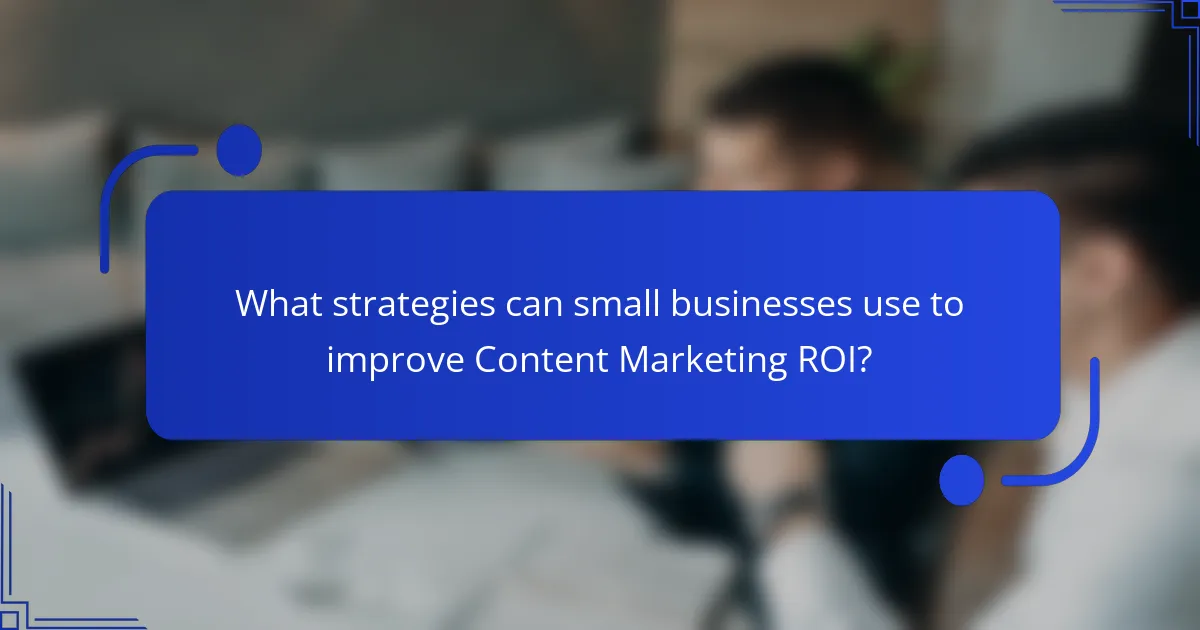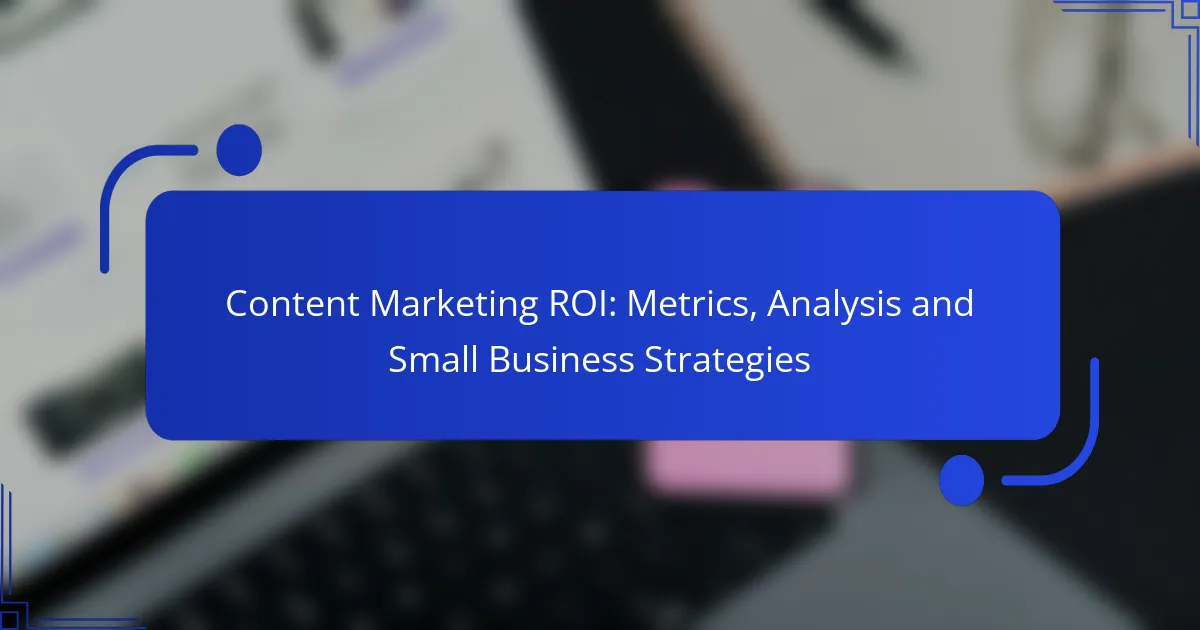Understanding Content Marketing ROI is crucial for small businesses aiming to maximize their marketing efforts and budget. By analyzing key metrics such as customer acquisition cost and conversion rates, businesses can evaluate the effectiveness of their content strategies. Implementing targeted content creation and leveraging social media can further enhance engagement and drive conversions, ultimately leading to a higher return on investment.

What are the key metrics for measuring Content Marketing ROI?
Key metrics for measuring Content Marketing ROI include customer acquisition cost, conversion rate, return on investment, customer lifetime value, and traffic growth. These metrics help businesses assess the effectiveness of their content strategies and make informed decisions to optimize their marketing efforts.
Customer Acquisition Cost
Customer acquisition cost (CAC) refers to the total expense incurred to acquire a new customer. This includes marketing expenses, sales costs, and any other resources dedicated to converting leads into customers. To calculate CAC, divide total marketing and sales expenses by the number of new customers gained during a specific period.
For small businesses, keeping CAC low is crucial. Aim for a CAC that is significantly lower than the customer lifetime value to ensure profitability. Regularly review and adjust your marketing strategies to reduce unnecessary expenses and improve efficiency.
Conversion Rate
The conversion rate measures the percentage of visitors who take a desired action, such as making a purchase or signing up for a newsletter. To calculate the conversion rate, divide the number of conversions by the total number of visitors and multiply by 100. A higher conversion rate indicates effective content marketing.
Small businesses should focus on optimizing their content to improve conversion rates. This can include A/B testing different headlines, calls to action, and landing page designs. Regularly analyze your conversion data to identify trends and areas for improvement.
Return on Investment
Return on investment (ROI) evaluates the profitability of your content marketing efforts. To calculate ROI, subtract the total costs of your marketing campaign from the total revenue generated, then divide by the total costs and multiply by 100. A positive ROI indicates that your content marketing is financially beneficial.
For small businesses, understanding ROI helps prioritize marketing strategies that yield the best results. Track ROI over time to identify successful campaigns and allocate resources effectively. Consider both short-term and long-term returns when assessing your content marketing investments.
Customer Lifetime Value
Customer lifetime value (CLV) estimates the total revenue a business can expect from a single customer throughout their relationship. To calculate CLV, multiply the average purchase value by the number of purchases per year and the average customer lifespan. A higher CLV suggests that investing in customer retention can be more beneficial than acquiring new customers.
Small businesses should focus on strategies that enhance customer loyalty, such as personalized content and excellent customer service. By increasing CLV, you can improve overall profitability and justify higher acquisition costs.
Traffic Growth
Traffic growth measures the increase in visitors to your website over time, indicating the effectiveness of your content marketing efforts. Analyze traffic data through tools like Google Analytics to track changes in visitor numbers, sources, and behavior. Consistent traffic growth can lead to higher conversion rates and sales.
To drive traffic growth, small businesses should regularly publish high-quality content, optimize for search engines, and promote their content through social media and email marketing. Monitor traffic trends to identify successful tactics and adjust your strategies accordingly.

How can small businesses analyze their Content Marketing ROI?
Small businesses can analyze their Content Marketing ROI by measuring the effectiveness of their content strategies through various metrics and tools. This analysis helps determine the financial return on investment relative to the costs incurred in creating and distributing content.
Utilizing Google Analytics
Google Analytics is a powerful tool for small businesses to track website performance and user behavior. By setting up goals and conversions, businesses can measure how content drives traffic and leads. For instance, tracking the number of visitors who complete a purchase or sign up for a newsletter can provide insights into content effectiveness.
To get started, ensure that Google Analytics is properly configured on your website. Regularly review reports on user acquisition, behavior, and conversions to identify which content pieces yield the best results.
Implementing A/B Testing
A/B testing allows small businesses to compare two versions of content to see which performs better. This method can be applied to headlines, images, or calls to action. For example, testing two different blog post titles can reveal which one attracts more clicks and engagement.
When conducting A/B tests, ensure that you have a clear hypothesis and a sufficient sample size to draw meaningful conclusions. Avoid making changes too frequently, as this can skew results and make it difficult to identify trends.
Tracking Engagement Metrics
Engagement metrics, such as time on page, bounce rate, and social shares, provide valuable insights into how audiences interact with content. High engagement often indicates that content resonates well with the target audience, while low engagement may signal a need for improvement.
To effectively track engagement, use tools like Google Analytics or social media insights. Focus on metrics that align with your business goals, such as increasing brand awareness or generating leads. Regularly analyze these metrics to refine your content strategy and improve ROI.

What strategies can small businesses use to improve Content Marketing ROI?
Small businesses can enhance their Content Marketing ROI by focusing on targeted content creation, leveraging social media platforms, and investing in email marketing. These strategies help in reaching the right audience, building engagement, and ultimately driving conversions.
Creating Targeted Content
Creating targeted content involves understanding your audience’s needs and preferences. Conducting market research can help identify key demographics and pain points, allowing you to tailor your content accordingly.
Use tools like Google Analytics and social media insights to gather data on your audience’s behavior. Aim to produce content that addresses specific questions or challenges your target market faces, which can lead to higher engagement and conversion rates.
Leveraging Social Media Platforms
Social media platforms are essential for promoting content and engaging with your audience. Choose platforms that align with your target demographic, such as Facebook for a broad audience or Instagram for a younger crowd.
Regularly post engaging content and interact with followers to build a community around your brand. Consider using paid advertising options on these platforms to increase visibility and reach a larger audience, which can significantly boost your ROI.
Investing in Email Marketing
Email marketing remains one of the most cost-effective strategies for small businesses. Building a quality email list allows you to directly reach interested customers with personalized content and offers.
Segment your email list based on customer behavior and preferences to send targeted messages. Use A/B testing to refine your email campaigns and track metrics like open rates and click-through rates to measure effectiveness and improve future efforts.

What are the prerequisites for effective Content Marketing analysis?
Effective content marketing analysis requires a solid foundation of clear goals and a well-defined target audience. Without these prerequisites, measuring success and optimizing strategies becomes challenging.
Defining Clear Goals
Establishing clear goals is essential for guiding content marketing efforts. Goals should be specific, measurable, achievable, relevant, and time-bound (SMART). For example, a small business might aim to increase website traffic by 20% over the next six months.
When defining goals, consider what metrics will indicate success, such as conversion rates, engagement levels, or lead generation. Regularly revisiting and adjusting these goals ensures they remain aligned with business objectives and market conditions.
Identifying Target Audience
Understanding your target audience is crucial for effective content marketing analysis. This involves researching demographics, interests, and behaviors to create detailed buyer personas. Knowing your audience helps tailor content to meet their needs and preferences.
Utilize tools like surveys, social media insights, and website analytics to gather data about your audience. This information can guide content creation, ensuring it resonates with the intended viewers and drives engagement.

How does Content Marketing ROI differ across various industries?
Content marketing ROI varies significantly across industries due to differing customer behaviors, engagement levels, and sales cycles. Understanding these differences helps businesses tailor their strategies to maximize returns.
Retail Industry Insights
In the retail sector, content marketing often focuses on driving immediate sales through promotions, product showcases, and customer testimonials. Retailers typically see a higher ROI from content that highlights seasonal sales or exclusive offers, as these can lead to quick conversions.
Successful retail content strategies often include visually appealing product videos, engaging social media posts, and informative blog articles that guide customers through their purchasing decisions. Utilizing platforms like Instagram and Pinterest can enhance visibility and drive traffic to online stores.
Retailers should track metrics such as conversion rates, average order value, and customer acquisition costs to assess the effectiveness of their content marketing efforts. Regularly analyzing these metrics can help refine strategies and improve ROI.
